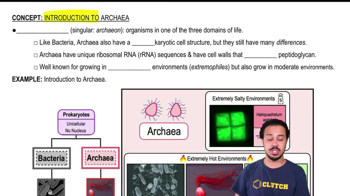What is a fiber composite? How do cellular fiber composites resemble reinforced concrete?
Ch. 6 - Lipids, Membranes, and the First Cells
Chapter 6, Problem 1
How do the phospholipids in archaea differ from those in other cells? a. They have tails made of unsaturated fatty acids instead of saturated fatty acids. b. They do not contain hydrocarbon chains. c. They have isoprenoid tails instead of fatty acid tails. d. They have two hydrocarbon chains instead of three hydrocarbon chains.
 Verified step by step guidance
Verified step by step guidance1
Step 1: Understand the question. The question is asking about the difference in the structure of phospholipids in archaea compared to other cells.
Step 2: Recall what you know about the structure of phospholipids. Phospholipids are a type of lipid molecule that is the main component of the cell membrane. They are composed of two fatty acid tails and a phosphate group.
Step 3: Evaluate each of the answer choices. Option a suggests that archaea have tails made of unsaturated fatty acids instead of saturated fatty acids. This is not the main difference between archaeal and other phospholipids. Option b suggests that archaeal phospholipids do not contain hydrocarbon chains. This is incorrect as all phospholipids, including those in archaea, contain hydrocarbon chains. Option d suggests that archaeal phospholipids have two hydrocarbon chains instead of three. This is also incorrect as all phospholipids, including those in archaea, have two hydrocarbon chains.
Step 4: Choose the correct answer. Option c suggests that archaeal phospholipids have isoprenoid tails instead of fatty acid tails. This is correct. The main difference between archaeal phospholipids and those in other cells is that archaeal phospholipids have isoprenoid chains, which are made up of repeating five-carbon units, instead of the fatty acid chains found in other phospholipids.
Step 5: Confirm your answer. Archaeal phospholipids are unique in that they have isoprenoid tails, which are more resistant to heat and other extreme conditions, making them well-suited to the harsh environments in which many archaea live.

Verified video answer for a similar problem:
This video solution was recommended by our tutors as helpful for the problem above.
Video duration:
1mWas this helpful?
Key Concepts
Here are the essential concepts you must grasp in order to answer the question correctly.
Phospholipid Structure
Phospholipids are molecules that form the fundamental structure of cell membranes. They consist of a hydrophilic (water-attracting) 'head' and two hydrophobic (water-repelling) 'tails.' The arrangement of these molecules creates a bilayer that serves as a barrier to protect the cell's interior while allowing selective permeability.
Recommended video:
Guided course

Phospholipids
Archaea vs. Bacteria/Eukarya
Archaea are a distinct group of microorganisms that differ from bacteria and eukaryotes in several ways, including their membrane composition. While bacteria and eukaryotes typically have phospholipids with fatty acid tails, archaea possess unique isoprenoid tails, which provide stability in extreme environments, such as high temperatures and salinity.
Recommended video:
Guided course

Introduction to Archaea
Isoprenoid Tails
Isoprenoid tails are branched hydrocarbon chains found in the phospholipids of archaea. Unlike the straight-chain fatty acids in other organisms, isoprenoids contribute to the rigidity and stability of archaeal membranes, making them more resilient to extreme conditions. This structural difference is crucial for the survival of archaea in harsh environments.
Recommended video:
Guided course

Rule of Multiplication (the AND Rule)
Related Practice
Textbook Question
1282
views
Textbook Question
A cell is placed in a solution that is hypotonic to the cell. Which of the following best describes movement of water in this situation? a. Water will only flow into the cell. b. Water will only flow out of the cell. c. Water will flow into and out of the cell, but the overall net movement will be out of the cell. d. Water will flow into and out of the cell, but the overall net movement will be into the cell.
1102
views
Textbook Question
If a solution surrounding a cell is hypertonic relative to the inside of the cell, how will water move? a. It will move into the cell via osmosis. b. It will move out of the cell via osmosis. c. It will not move, because equilibrium exists. d. It will evaporate from the cell surface more rapidly.
1344
views
